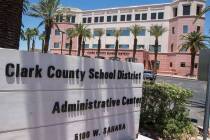Some CCSD teachers forge ahead with online learning
Spring Valley High School teacher William Hemberger faced a daunting task on Tuesday: adapting his Socratic seminar — a teaching technique dating back to 400 B.C. — to a Google videoconference.
He was one of dozens of teachers across the Clark County School District forging ahead with online learning during school closures in the absence of a districtwide plan from CCSD that can reach all students.
Educators, many of whom were using online learning platforms for the first time, tried different approaches to see what works best on video. Sierra Vista High biology teacher Brianna Cotter started a book club. Paul Kleemann at Del Sol Academy used it to teach guitar.
CCSD has offered curriculum options for teachers and students who want to try online education, from Khan Academy to a new platform called ActivelyLearn. But all schoolwork remains voluntary as online learning is simply not an option for some students.
Superintendent Jesus Jara said Monday that if the district had rolled out online learning on Monday to comply with a request from the state superintendent, some 120,000 students would not have been able to access it because they don’t have computers or internet access at home.
It’s a multifaceted problem, according to Kenneth Retzl, education policy director at the Guinn Center, who said physical access to devices is just half the battle. Even if Chromebooks could be distributed to all students who need them, Retzl said those devices would then need an internet connection, and then one strong enough to support uploading and video calling.
“It shows how many barriers students face to a quality education,” Retzl said. “We know the difficulties of getting students food, but now they need to be educated, too.”
Funding shifted
Retzl said the Guinn Center is currently conducting its own analysis of the digital divide, adding that it’s not clear how CCSD derived its figure of 120,000 students lacking access. He said he believes a deeper understanding of the access gap could be found by comparing areas known to have less access to devices with data on the age of the people in those households.
A CCSD spokesperson said Tuesday that funding is a barrier to providing devices to all students. The school district once used Title I funds to move middle schools to a 1:1 ratio but has since shifted those funds to other needs.
Some administrators have purchased additional devices using funds from the school’s strategic budget. Whether those devices can be taken home is a site-based decision under normal instruction, but no guidance has been issued yet under the current situation.
At an emergency School Board meeting on Monday, Trustee Deanna Wright also questioned why Nevada Ready 21, a statewide initiative to offer 1:1 access to devices, had not been rolled out more broadly in the district.
Nevada Ready 21 was funded by block grants through Assembly Bill 309, which allowed districts to spend the money on certain initiatives like technology or employee salary increases. Jara said CCSD used it for the latter purpose.
Retzl said that part of the issue has also been the debate over how much screen time kids should have.
“There’s a tension in the community during nonpandemic times about how much priority we should place on technology versus learning with teachers,” he said.
Given the inability to rely solely on online solutions, the district has put much of its energy into making learning packets available to students. So far the district has distributed them online and at each of its 28 food distribution sites, but Jara said Monday it also is exploring other solutions such as mailing them to every student’s home. He also announced later in the day a new learning hotline to answer students’ questions on coursework.
Mojave High Principal Gregory Cole said packets have been a popular option at his school, where over 80 percent of students are economically disadvantaged.
Cole said the neighborhood around his school was hard-hit by the Recession and that he expects the economic downturn caused by the coronavirus pandemic to have a similar effect on his students and their families.
“Just because they had Wi-Fi last week doesn’t mean they’ll have it this week,” he said. “Or if they have access to a phone or computer right now, it doesn’t mean a choice won’t need to be made to pay a bill.”
Phones not a good learning option
Cole said he believes he has enough Chromebooks on hand for students who need them but is awaiting guidance from the district on how to proceed.
While most of his students have phones, Cole said, he believes they rely on school Wi-Fi and wouldn’t have enough data available to participate in online classes on their phones alone.
For now, he said he’s asking teachers to make contact with students weekly primarily to check on their well-being and provide them with information about food distribution. Jara said Tuesday that educators districtwide are also trying to make contact with students this week, with about 90,000 students reached so far.
The technology divide cuts both ways, as some teachers say they don’t feel comfortable shifting their classes online because they haven’t been trained on online classrooms. But Hemberger said they shouldn’t be afraid to fail.
He said his own first stab at online learning didn’t go well, but after a trial run on Monday, he figured out a way to conduct the group discussion necessary to a Socratic seminar: lining students up in a digital queue and muting and unmuting their mics one at a time to allow all 29 to speak.
Approximately 20 students invited to the session were missing, he said, some in part due to lack of access, but others because they chose not to participate.
Some students who did attend reported issues: Missy May Grimares Valdez said without her own room, it was tough to focus on a video class.
But on Tuesday, the class held its session for over an hour without interruption.
“With lecture-heavy classes, it’s harder to grasp the material,” student Kenna Scott said of online classes. “But when it’s discussion-prone like this, it’s really beneficial.”
More flexibility for charters
Southern Nevada’s charter schools have had considerable leeway to develop their own distance learning plans, according to State Public Charter School Authority Executive Director Rebecca Feiden. The authority offered guidance and weekly phone calls as schools submitted their initial plans, which for schools like Founders Academy and Signature Preparatory, focus on hard copy materials.
Founders Academy history teacher Connor Mullin is trying an online class. He said that while he had no prior experience with Zoom or any other videoconferencing platform, he found it easy to use and has encouraged other teachers to try it.
His second-ever online class on Tuesday experienced some technical difficulties when his internet connection dropped briefly, but a restart allowed the lecture to continue.
Somerset Academy Lone Mountain is allowing students who don’t have devices to check them out from the school. On Tuesday, Denise Burchell’s kindergarten students sat in adult-sized office chairs to attend class via Zoom, beginning their morning reading with a sentence that their teacher displayed via screen-share.
Burchell said her administrators steered teachers toward Zoom and provided training but allowed her the flexibility to decide how to use the platform. She logs in twice a day for 30 minutes to meet with her students, leading an activity in the mornings and saving time for questions in the afternoon.
The 5- and 6-year-olds sounded out the sentence and listened to a story, and ended the morning session with show-and-tell. Burchell said she misses her students, but they seem to like their new virtual kindergarten.
“I like it because we can see our families,” agreed student Deegan Blood.
Contact Aleksandra Appleton at 702-383-o218 or aappleton@reviewjournal.com. Follow @aleksappleton on Twitter.




























